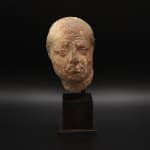Portrait of the Emperor Vespasian, AD 100 – AD 200
Marble
12.5 x 9 x 10 cm
4 7/8 x 3 1/2 x 4 in
4 7/8 x 3 1/2 x 4 in
P.3360
Further images
-
(View a larger image of thumbnail 1
)

-
(View a larger image of thumbnail 2
)

-
(View a larger image of thumbnail 3
)

-
(View a larger image of thumbnail 4
)

-
(View a larger image of thumbnail 5
)

-
(View a larger image of thumbnail 6
)

-
(View a larger image of thumbnail 7
)

-
(View a larger image of thumbnail 8
)

-
(View a larger image of thumbnail 9
)

-
(View a larger image of thumbnail 10
)

-
(View a larger image of thumbnail 11
)

-
(View a larger image of thumbnail 12
)

AD 69 was a disastrous year for Rome: the Year of the Four Emperors. There were several rebellions, civil war, shifting allegiances, and breakaway provinces. The Empire seemed on the...
AD 69 was a disastrous year for Rome: the Year of the Four Emperors. There were several rebellions, civil war, shifting allegiances, and breakaway provinces. The Empire seemed on the brink, and someone remarkable was needed to bring it back together. In the end, that remarkable person was Vespasian, the first of the Flavian Emperors. Already 60 years old by the time he became Emperor, Vespasian’s career had started out slow. He was born as the son of a tax-collector, among the equites, the mercurial middle classes who so often had turned on Emperors in the past. He joined the Roman military, serving under Claudius in Britain. He then rose steadily to Senatorial rank, taking on roles as general in Rome’s provinces in the East. It was while he was suppressing the Jewish Revolt in Jerusalem that the Emperor Nero died, and set into motion the chaos of the Year of the Four Emperors. Vespasian saw his chance, and took control of the grain supplies of Egypt, essential for feeding food-poor Rome. He held this grain to ransom while his troops invaded northern Italy; within weeks, Vespasian was declared the new Emperor.
Vespasian’s role in bringing together the disparate threads of the Empire at a time of such great crisis ensured his fame both among the Romans of his day, and the generations to come. He was a competent Emperor, reforming the financial system, and embarking on fabulous construction projects, including the Flavian Amphitheatre (now Rome’s famous Colosseum). As a result, the sculptors of a later period were willing to make Vespasian their subject. He is depicted here, as in all of his portraiture, as an older man; perhaps less vigorous, but dependable. Unlike the earlier Emperors, less concern is given to the impression of athleticism or godliness. Vespasian is balding, overweight, and shows the wrinkles of his age. His eyes are downcast, reflecting his contemplative spirit, and the wisdom that comes with a life of experience. His nose is straight and symmetrical, perhaps the one nod to idealism, while his lips are lowered into a sombre expression. His thick neck is at an angle; the original full-length sculpture would have been in the traditional contrapposto, a pose in which the neck is twisted, the weight is on one hip, and the other leg is straight.
This portrait reflects the realism that pervaded the imagery of the Flavian dynasty. It demonstrates an Emperor who was at ease with himself and with his position. A competent leader, who was ready to steer the Empire through the challenging times of the late First Century. While his reign may not have been as long and spectacular as those of Augustus or Hadrian, in the image of Vespasian, we have a link to one of the most important Emperors in Roman history.
Vespasian’s role in bringing together the disparate threads of the Empire at a time of such great crisis ensured his fame both among the Romans of his day, and the generations to come. He was a competent Emperor, reforming the financial system, and embarking on fabulous construction projects, including the Flavian Amphitheatre (now Rome’s famous Colosseum). As a result, the sculptors of a later period were willing to make Vespasian their subject. He is depicted here, as in all of his portraiture, as an older man; perhaps less vigorous, but dependable. Unlike the earlier Emperors, less concern is given to the impression of athleticism or godliness. Vespasian is balding, overweight, and shows the wrinkles of his age. His eyes are downcast, reflecting his contemplative spirit, and the wisdom that comes with a life of experience. His nose is straight and symmetrical, perhaps the one nod to idealism, while his lips are lowered into a sombre expression. His thick neck is at an angle; the original full-length sculpture would have been in the traditional contrapposto, a pose in which the neck is twisted, the weight is on one hip, and the other leg is straight.
This portrait reflects the realism that pervaded the imagery of the Flavian dynasty. It demonstrates an Emperor who was at ease with himself and with his position. A competent leader, who was ready to steer the Empire through the challenging times of the late First Century. While his reign may not have been as long and spectacular as those of Augustus or Hadrian, in the image of Vespasian, we have a link to one of the most important Emperors in Roman history.











